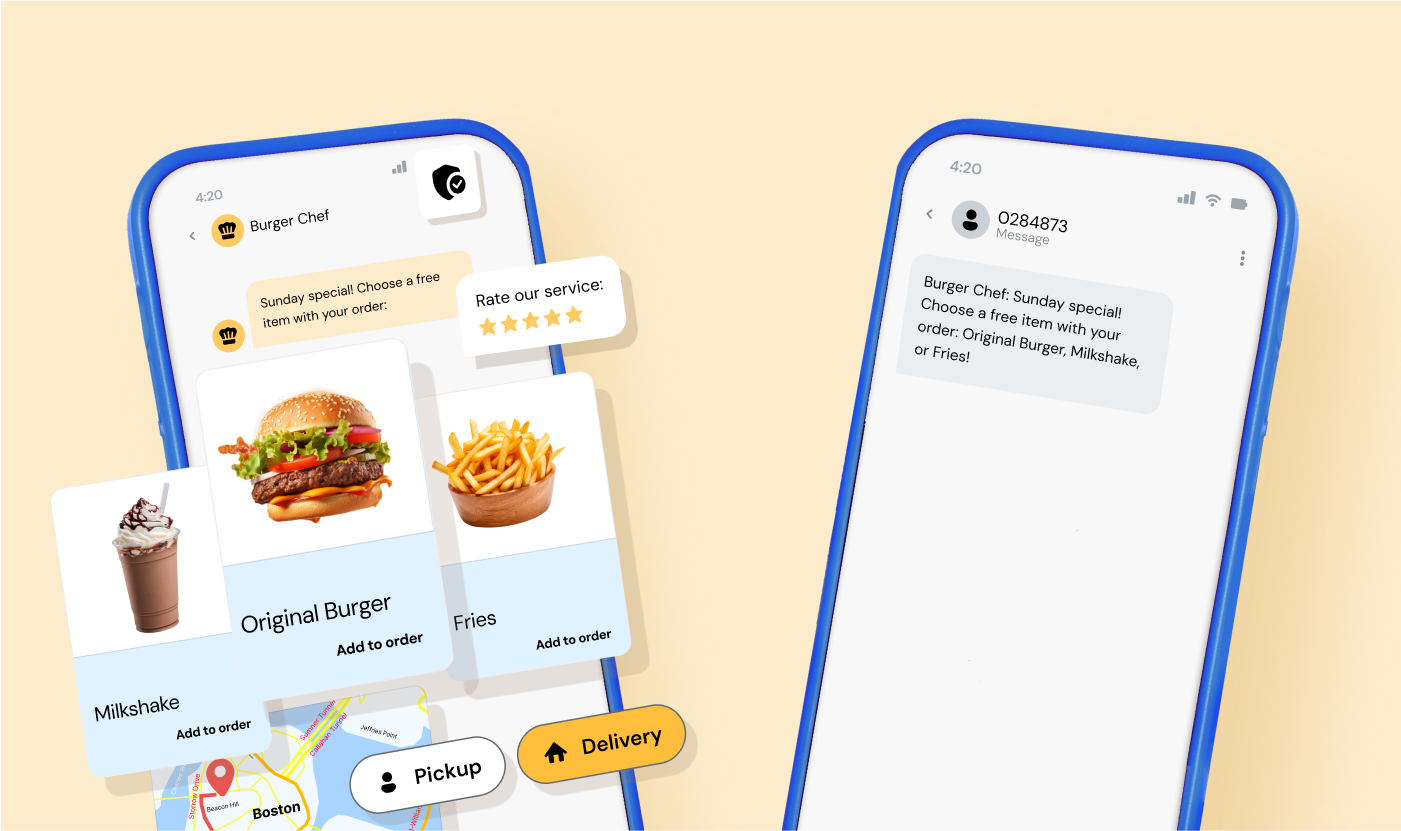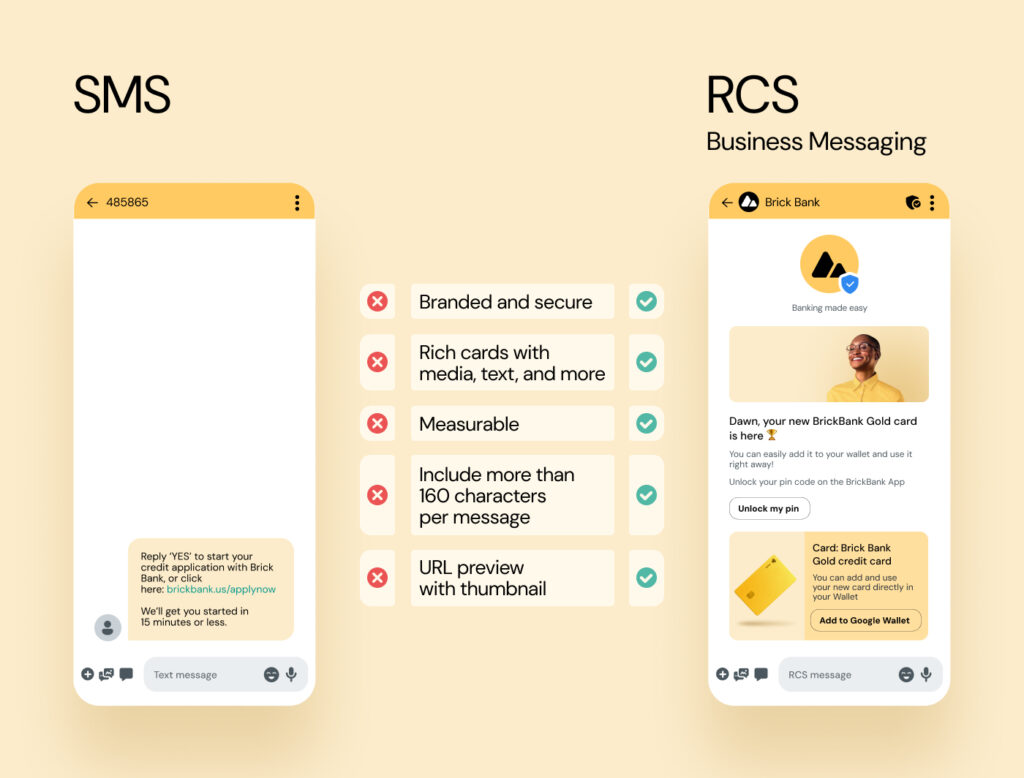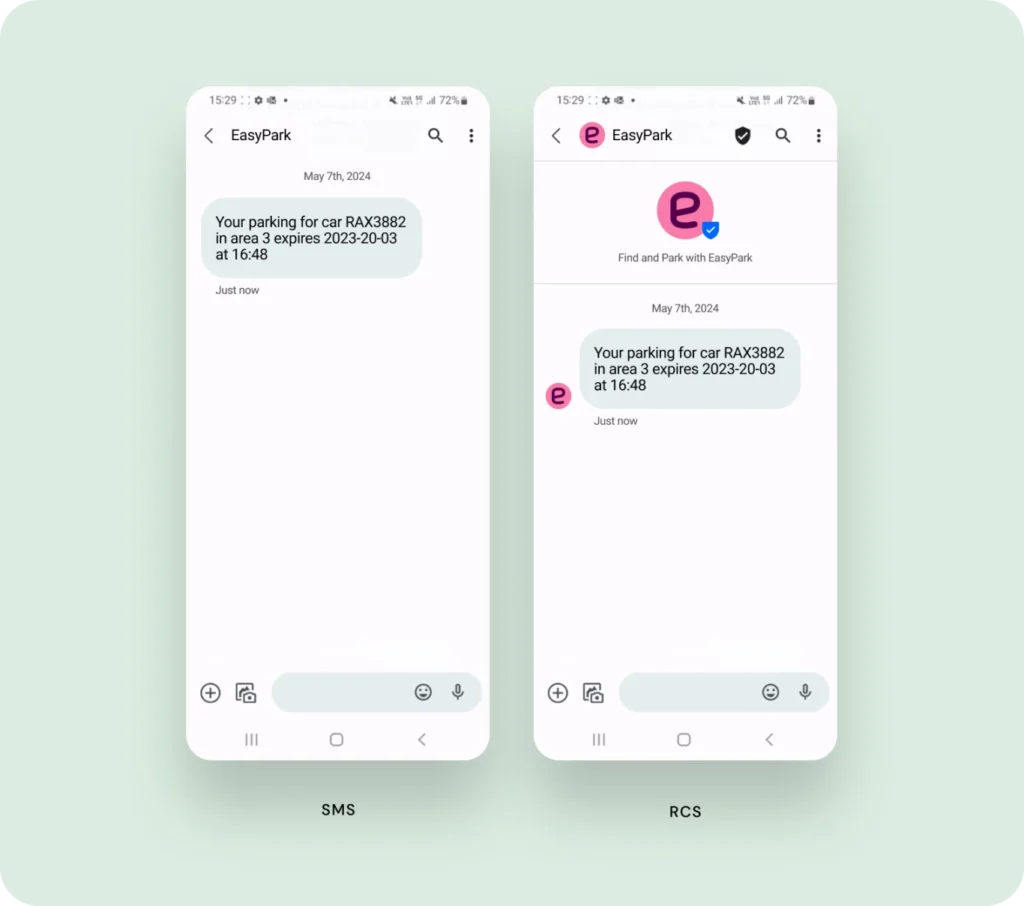Insights
RCS vs. SMS: How are they different?

Insights

It all started with a simple “Merry Christmas.” That was the first-ever Short Messaging Service (SMS) message sent over 30 years ago, kicking off a new way for people to communicate. SMS quickly became peoples’ go-to messaging technology, offering a fast, reliable, and universally supported way for them to connect.
Fast forward to today, and mobile messaging has evolved in ways no one could have ever imagined, including with the introduction of Rich Communication Services (RCS). RCS messaging brings branded, interactive, and media-rich experiences directly to the same native mobile inbox as SMS. While SMS remains the most universal messaging channel, RCS enhances what’s possible.
For years, RCS was only available on Android devices. But now, with Apple RCS support rolling out in different markets, the impact is huge for both consumers and businesses. And this is because with RCS, brands can complement their SMS marketing strategies with branded, rich, and dynamic messaging experiences.
So, how do SMS and RCS compare? Let’s break down the benefits of both SMS and RCS, and dig into how they can help you engage with your customers effectively, if a little differently.
SMS is the most established and widely used texting technology in the world. Because nearly every mobile device is SMS-compatible, you can use SMS to reach almost anyone – no Wi-Fi or data network required. This also makes it a reliable fallback option when messages over other channels can’t get delivered.
And in 2025, texting remains the top mobile activity for 83% of consumers, outpacing social media (75%) and email (66%). Businesses rely on SMS for its broad reach and reliability, making sure their messages get delivered no matter what.
An enhanced version of SMS, called Multimedia Messaging Service (MMS), allows users to send images, audio, and video over the cellular network. However, MMS lacks the interactivity of messaging channels like RCS or WhatsApp.
While SMS supports two-way communication (like by replying to SMS messages sent via a short code), its capabilities are limited compared to RCS. As messaging evolves, SMS will continue to have an important place in business communication, but richer options like RCS are opening the door for businesses to have richer, more engaging conversations with customers.
RCS is a messaging protocol with rich chat features like video, images, and interactive elements. RCS works like an over-the-top (OTT) app like iMessage or WhatsApp, providing a more dynamic experience for both Android and Apple users.
The key difference? RCS delivers right within a phone’s native messaging app, requiring no third-party app (or need to own an iPhone, as is the case for iMessage) to access modern messaging features like high-resolution media, read receipts, group chats, typing indicators, and more.
These features not only enhance the user experience but also make RCS a powerful tool for business messaging – one that drives higher interaction rates than SMS. In fact, in 2024, we found that 51.2% of consumers said that they’d engage with RCS messages – showing a strong appetite for rich, branded messaging.

RCS allows brands to engage customers with high-quality, feature-rich multimedia messaging delivered over Wi-Fi or a cellular data connection (like 4G or 5G). And its business solution, RCS for Business (previously called “RCS Business Messages” or “RBM”), offers a few key advantages over business SMS, including:
“One of the benefits you’re going to see with RCS is that as a consumer, when you interact with a brand, you’re going to see the brand’s logo and name… [and as an end consumer], I’m going to trust the brand more because I’m seeing it’s the actual brand. Instant brand recognition.”

As a subscriber, receiving an RCS message vs. an SMS message can be quite different. For one, while SMS is sent over the cellular network, RCS content requires mobile data capabilities or an internet connection. Other key differences come down to reach, media capabilities, and branding. Check out the table below for a quick comparison!
| RCS | SMS | |
| Usability | No app to download; available on Android and iOS 18 in select markets. | No app to download; available on nearly all mobile devices (including Androids and iPhones). |
| Network dependency | Requires data connectivity (5G, LTE) or an internet connection before a message can be transmitted. | Transmitted via a mobile network provider’s infrastructure, meaning a Wi-Fi connection isn’t required. |
| Reach | Currently over one and a half billion active Android users and expanding with continued Apple device support. | 100% of mobile phone users on the planet (approx. 7.3 billion people). |
| Text capabilities | Text portions of RCS messages are limited to 3072 characters. | Up to 160 characters in a single SMS message. |
| Media capabilities | Supports rich cards, buttons, maps images, video, audio, GIFs, and more. | No multimedia content or suggested actions can be included, but MMS supports images and links. |
| Security and encryption | RCS messages are encrypted in transit, with end-to-end encryption for P2P messages on Android (coming soon to iOS). | Neither SMS nor MMS are encrypted. |
| User experience | Offers features like interactive buttons and quick-reply buttons. | Offers text chat features. |
| Engagement | Very high – 90% of rich media messages are opened within 15 minutes, with up to 45 seconds of engagement. | Very high – historically has had an open rate of over 90%. |
| Branding opportunities | All messages include a brand, name, logo, and verified sender information. | Some select countries allow for Alpha Sender IDs, but they’re not universally available. |
As you can see, RCS and SMS have quite a few differences when it comes to reach, security, and functionality.
Whether SMS or RCS is better for marketing depends on your goals. SMS is reliable and reaches almost everyone, while RCS offers branded, interactive experiences for compatible devices. And that richer experience matters: In 2024, our Customer Connections survey found that customers are increasingly frustrated with generic, text-only messages – they want two-way interactions, quick replies, and visuals that aid decision making.
If you’re looking to meet those expectations and drive deeper engagement, RCS may be the better fit. But depending on your use case, SMS still has advantages. Here’s a quick breakdown to help you choose:
Use RCS if:
Use SMS if:
There’s no one-size-fits-all messaging channel – and that’s a good thing. Many businesses find success using a mix of SMS and RCS to get the best of both worlds.
SMS is perfect for basic text messages up to 160 characters, while RCS chat offers richer, more engaging features, longer messages, and the opportunity to add your brand’s personality into the conversation.
The easiest approach? Use an API that will allow you to auto-upgrade SMS to RCS where possible and stick with SMS where needed. This strategy will help you reach the widest audience possible, without extra effort.
Let’s dive into some specific use cases of businesses using RCS and SMS.
Picard, the premium frozen food brand, used RCS to increase customer engagement during the busy holiday season. While they were initially using email and SMS, they turned to RCS to create a more interactive experience. They created a personalized, conversational messaging experience where customers shared their preferences and got a custom holiday menu, all within their messaging app.
The result? RCS outperformed SMS with three times the click-through rate, as well as 42% more engagement and 10% more clicks to their website – plus it gave them valuable data not available from SMS.
“Unlike traditional SMS campaigns, RCS provides insights into delivery and open rates, allowing for better campaign monitoring.”
The American Automobile Association (AAA) used two-way SMS to boost its customer support function after realizing many texts to their helpline were going unanswered. With this new solution, users could text a toll-free number for roadside assistance and receive a link to submit a request, all without ever speaking to an agent.
Using SMS for this purpose ensured messages were delivered, even if the driver was off-road or without data.
The results? An 8% conversion rate to roadside assistance and $30,000 in soft cost savings.
conversion rate to roadside assistance
in cost savings
EasyPark, a leader in digital parking, relies on both SMS and RCS to deliver critical notifications. Transactional messages, like parking reminders, need to be delivered reliably to keep customers trusting the service – so SMS was their go-to for wide coverage.
But EasyPark went a step further by rolling out RCS for users in Germany. With RCS, they deliver a more secure, branded experience for users with RCS-compatible devices.

And the results? 40% of their messages were sent via RCS in Germany, with a 97.4% delivery rate.
RCS was once exclusive to Android. But starting in September 2024 with iOS 18, Apple started to roll out RCS and RCS for Business in select markets and with certain carriers – an exciting step forward and we expect additional rollout, but no timeline from Apple is confirmed.
While Apple supports RCS, it’s most commonly used on Android’s Google Messages app. Android users can enable RCS in the “Settings” menu and browsing “chat features.” Or, if you’re an iPhone user, you may be able to turn on RCS in iOS in “Settings,” under “Messages.”
Since SMS works on every mobile device with a network connection, combining SMS and RCS ensures brands can reach every customer, no matter their phone or network.
Still have questions? Here’s a quick FAQ to clear things up.
It depends on your audience and goals. SMS is the gold standard for reach – it works on virtually every mobile phone, no data or special setup required. RCS, on the other hand, brings rich formats, branded interactions, and better analytics – but it only works on supported devices with a data connection. The best strategy? Combine both using an API that uses RCS where it’s available and sends SMS if it’s not. That way, you get broad coverage and richer engagement when possible.
If your phone is using RCS, it likely means you’ve got a compatible Android device (or iOS 18 and above in select markets) and an active internet connection. Want to switch back to SMS/MMS? You can toggle it off in your phone’s settings (but why would you want to?).
RCS needs data or Wi-Fi, so it doesn’t work offline like SMS. It’s also not universally supported yet. For urgent or time-sensitive updates, SMS is still more reliable.
There’s usually no need to turn off RCS – it’s designed to enhance your messaging, not complicate it. But if you’re having issues or want to reduce data usage, turning it off is easy – and your messages should default back to SMS.
Nope! RCS works right in your phone’s default messaging app – no need to install anything new. If your phone supports RCS, it’ll work in your default messaging app – no downloads required.
Whatever your customer engagement goals, there’s a solution to help you succeed. Need to provide a more interactive, engaging experience or want to build trust with verified, branded messaging? RCS can bring your messaging to life. Looking for a reliable way to send critical notifications? SMS gets the job done, no matter the device.
If you’re ready to explore RCS, download our comprehensive guide to learn how to make the case for it in your organization.
Or, if you’re looking to build a smarter messaging strategy, let’s chat! We’re here to help you create meaningful customer connections that drive real results.